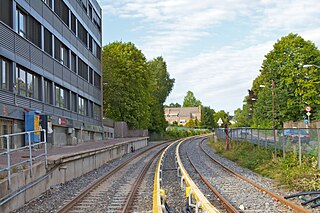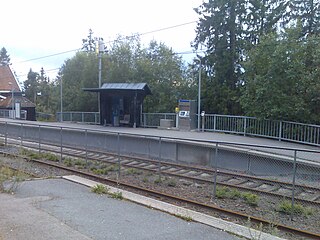
Holmenkollen is a mountain and a neighbourhood in the Vestre Aker borough of Oslo, Norway. It goes up to 500 metres (1,600 ft) above sea level and is well known for its international skiing competitions.

The Holmenkollen Line is an 11.4-kilometre-long (7.1 mi) Oslo Metro line which runs between Majorstuen and Nordmarka in Oslo, Norway. Operating as Metro Line 1, it is the route with the fewest passengers and the only one still to have level crossings and short station platforms. The line runs mostly through residential areas of detached houses, and the upper parts of the line principally serve the recreational area of Nordmarka. Holmenkollen Station is located close to Holmenkollen National Arena which hosts international Nordic skiing tournaments. Voksenkollen Station is not far from Oslo Vinterpark (Winter) and the Oslo Sommerpark (Summer).

Frøen is a rapid transit station of the Oslo Metro's Holmenkollen Line and previously also the Sognsvann Line. It is situated Frøen neighborhood of the Oslo, Norway, borough of Vestre Aker. Located 3.2 kilometers (2.0 mi) from Stortinget, the station is served by Line 1 of the metro every fifteen minutes. Travel time to Stortinget is six minutes. Diakonhjemmet Hospital falls within the station's catchment area.

Frognerseteren is the end station of the Holmenkollen Line of the Oslo Metro, located in the Marka section of Oslo, the capital city of Norway. It's the northernmost station in Oslo Metro, and is the station after Voksenkollen. The line to Frognerseteren was completed on 16 May 1916. The station has two platforms which, like other stations on the Holmenkollen Line, only accommodate two-car trains. The elevation of the station is 469 meters (1,539 ft) above sea level, the highest of all the stations in Oslo. The elevation difference between this station and the lowest in Oslo Metro (Stortinget), 478 meters (1,568 ft), is the highest elevation difference within a metro network in the world.

Ris is a rapid transit station of the Oslo Metro's Holmenkollen Line. It is situated in the Ris neighborhood of the Oslo, Norway, borough of Vestre Aker. Located 5.2 kilometers (3.2 mi) from Stortinget, the station is served by Line 1 of the metro every fifteen minutes. Travel time to Stortinget is 11 minutes. The station opened on 31 May 1898. A shed was moved to the station in 1916. There are proposals to extend the platforms.

Gaustad is a rapid transit station of the Oslo Metro's Holmenkollen Line. It is situated Gaustad neighborhood of the Oslo, Norway, borough of Vestre Aker. Located 4.7 kilometers (2.9 mi) from Stortinget, the station is served by Line 1 of the metro every fifteen minutes. Travel time to Stortinget is ten minutes. The National Hospital and several research institutes fall within the station's catchment area.

Besserud is a station on the Holmenkollen Line on the Oslo Metro, between Midtstuen and Holmenkollen.

Midtstuen is a station on the Holmenkollen Line on the Oslo Metro, between Skådalen and Besserud. It is the lower end of the popular tobogganing course Korketrekkeren. Midtstuen is located at an altitude of 223.3 meters (733 ft).

Voksenkollen is a station on the Holmenkollen Line of the Oslo Metro. It is the penultimate station on the line, between Lillevann and Frognerseteren. It is also the second highest station on the network, 460 meters (1,510 ft) above mean sea level. The station was opened on 16 May 1916 when the line was extended from Besserud to Frognerseteren.

Lillevann is a station on the Holmenkollen Line on the Oslo Metro. The station is located between Skogen and Voksenkollen, at an altitude of 425 m (1,394 ft) above mean sea level. The station was opened on 16 May 1916 with the extension of the line from Besserud, but the station building is older. That building was built in 1898 on an estate at Besserud, but then moved to Lillevann. The architect was Paul Due.

Skogen is a station on the Holmenkollen Line located between Voksenlia and Lillevann, in Oslo, Norway. The station is at an altitude of 378 meters (1,240 ft) above mean sea level. The station was opened on 16 May 1916 with the extension of the line from Besserud to Frognerseteren. The architect for the station was Erik Glosimodt.

Steinerud is a rapid transit station of the Oslo Metro's Holmenkollen Line. It is situated in the Steinerud neighborhood of the Oslo, Norway, borough of Vestre Aker. Located 3.8 kilometers (2.4 mi) from Stortinget, the station is served by Line 1 of the metro every fifteen minutes. Travel time to Stortinget is seven minutes. Diakonhjemmet Hospital falls within the station's catchment area.

Vinderen is a rapid transit station of the Oslo Metro's Holmenkollen Line. It is situated Vinderen neighborhood of the Oslo, Norway, borough of Vestre Aker. Located 4.2 kilometers (2.6 mi) from Stortinget, the station is served by Line 1 of the metro every fifteen minutes. Travel time to Stortinget is nine minutes. Vinderen is neighborhood center and mostly a residential area. The platforms are located on each side of a level crossing.

Gråkammen is a station on the Holmenkollen Line of the Oslo Metro. It is located between Gulleråsen and Slemdal. The station was opened on 31 May 1898 as part of the tramway to Besserud. It derives its name from the surrounding hillocks.

Gulleråsen is a station on the Holmenkollen Line of the Oslo Metro. It is between Vettakollen and Gråkammen. The station was opened on 31 May 1898 as part of the tramway to Besserud.

Vettakollen is a station on the Holmenkollen Line of the Oslo Metro. It is located between Skådalen and Gulleråsen. The station was opened on 31 May 1898 as part of the light rail to Holmenkollen. The station was originally opened as Greveveien, but changed its name a few months after the opening.

Skådalen is a station on the Holmenkollen Line of the Oslo Metro. It is between Midtstuen and Vettakollen. The station was opened on 31 May 1898 as part of the tramway to Besserud.

Voksenlia is a station on the Holmenkollen Line of the Oslo Metro. It is between Skogen and Holmenkollen. The station was opened on 16 May 1916 when the tramway was extended to Frognerseteren. The station was originally called Lia.
Tryvandshøiden was a planned station on the Holmenkollen Line in Oslo, Norway. It was planned by the company Tryvandsbanen in the early 1910s and partly constructed in 1916 at the end of a single-tracked line from Frognerseteren. A red signalman's house named "Norden" was the station's only facility. Passenger trains never served the station, and the tracks from Frognerseteren to Tryvandshøiden were removed in 1939. The signalman's house was not demolished. In 1993, 2004 and 2008, proposals were made to re-open the station so that it would be more convenient for Oslo residents to use the Tryvann Ski Resort. However, these proposals were all rejected by the operator Oslo Sporveier on the grounds that the extension would be too expensive.
A/S Tryvandsbanen was a Norwegian company that constructed a rail extension nicknamed Tryvandsbanen of the Holmenkoll Line from Besserud to Tryvandshøiden station. The company was established 4 January 1912 and opened the Tryvann Line 15 May 1916. Tryvandsbanen was disestablished on 1 January 1920.


















